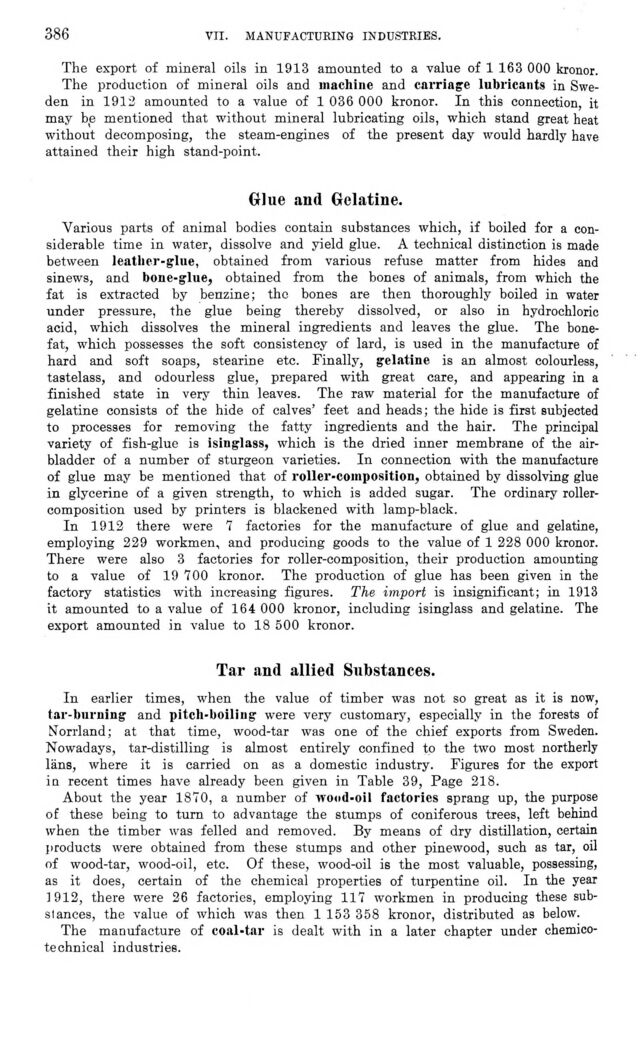
Full resolution (JPEG) - On this page / på denna sida - VII. Manufacturing Industries. Introd. by [G. Sundbärg] K. Åmark - 4. Oils, Tar, India-Rubber, and allied Commodities. By Alf. Larson

<< prev. page << föreg. sida << >> nästa sida >> next page >>
Below is the raw OCR text
from the above scanned image.
Do you see an error? Proofread the page now!
Här nedan syns maskintolkade texten från faksimilbilden ovan.
Ser du något fel? Korrekturläs sidan nu!
This page has never been proofread. / Denna sida har aldrig korrekturlästs.
386
vii. manufacturing industries.
The export of mineral oils in 1913 amounted to a value of 1 163 000 kronor.
The production of mineral oils and machine and carriage lubricants in
Sweden in 1912 amounted to a value of 1 036 000 kronor. In this connection, it
may bp mentioned that without mineral lubricating oils, which stand great heat
without decomposing, the steam-engines of the present day would hardly have
attained their high stand-point.
Glue and Gelatine.
Various parts of animal bodies contain substances which, if boiled for a
considerable time in water, dissolve and yield glue. A technical distinction is made
between leather-glue, obtained from various refuse matter from hides and
sinews, and bone-glue, obtained from the bones of animals, from which the
fat is extracted by benzine; the bones are then thoroughly boiled in water
under pressure, the glue being thereby dissolved, or also in hydrochloric
acid, which dissolves the mineral ingredients and leaves the glue. The
bone-fat, which possesses the soft consistency of lard, is used in the manufacture of
hard and soft soaps, stearine etc. Finally, gelatine is an almost colourless,
tastelass, and odourless glue, prepared with great care, and appearing in a
finished state in very thin leaves. The raw material for the manufacture of
gelatine consists of the hide of calves’ feet and heads; the hide is first subjected
to processes for removing the fatty ingredients and the hair. The principal
variety of fish-glue is isinglass, which is the dried inner membrane of the
air-bladder of a number of sturgeon varieties. In connection with the manufacture
of glue may be mentioned that of roller-composition, obtained by dissolving glue
in glycerine of a given strength, to which is added sugar. The ordinary
roller-composition used by printers is blackened with lamp-black.
In 1912 there were 7 factories for the manufacture of glue and gelatine,
employing 229 workmen, and producing goods to the value of 1 228 000 kronor.
There were also 3 factories for roller-composition, their production amounting
to a value of 19 700 kronor. The production of glue has been given in the
factory statistics with increasing figures. The import is insignificant; in 1913
it amounted to a value of 164 000 kronor, including isinglass and gelatine. The
export amounted in value to 18 500 kronor.
Tar and allied Substances.
In earlier times, when the value of timber was not so great as it is now,
tar-burning and pitch-boiling were very customary, especially in the forests of
Norrland; at that time, wood-tar was one of the chief exports from Sweden.
Nowadays, tar-distilling is almost entirely confined to the two most northerly
läns, where it is carried on as a domestic industry. Figures for the export
in recent times have already been given in Table 39, Page 218.
About the year 1870, a number of wood-oil factories sprang up, the purpose
of these being to turn to advantage the stumps of coniferous trees, left behind
when the timber was felled and removed. By means of dry distillation, certain
products were obtained from these stumps and other pinewood, such as tar, oil
of wood-tar, wood-oil, etc. Of these, wood-oil is the most valuable, possessing,
as it does, certain of the chemical properties of turpentine oil. In the year
1912, there were 26 factories, employing 117 workmen in producing these
substances, the value of which was then 1 153 358 kronor, distributed as below.
The manufacture of coal-tar is dealt with in a later chapter under
chemico-technical industries.
<< prev. page << föreg. sida << >> nästa sida >> next page >>